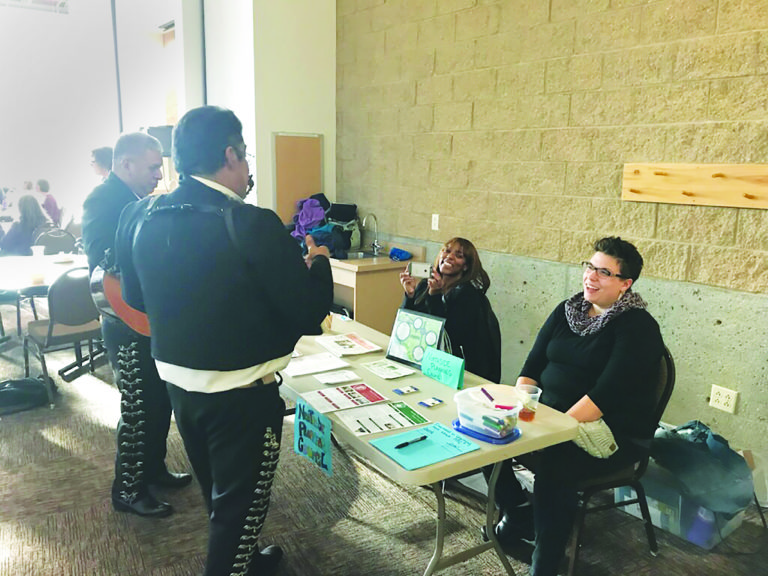
By Abha Thakkar
Northside Planning Council
The Northside Stable Families, Strong Community (SFSC) collaboration kicked off in June with the hiring of seven Neigbhorhood Navigators, Northsiders who were identified to help us more effectively reach a racially and economically diverse group of neighbors around issues that affect family stability. Employed by the Northside Planning Council (NPC), the Navigators spent their summer meeting residents, building trust, conducting surveys and focus groups and attending dozens of events as community ambassadors. The feedback they gathered encompassed over a dozen topics such as housing, childcare, education, safety, and employment and will help guide the next steps of SFSC. Partners include the Safe & Thriving Community (STC) initiative, the Northside Early Childhood Zone, the Mendota Community School, the Northside Planning Council, and various other Northside nonprofit programs, civic groups, and city and county agencies.
As a component of this collaboration, STC specifically targets the underlying causes of youth violence. STC is funded by a federal grant which the City received in late 2016. The Northside was identified as the focal community for this work, and efforts got started in early 2017. The first phase of the project entailed a planning period that required community input, and the Navigators helped ensure that we reached a representative sample of residents.
Of the hundreds of residents Navigators connected with, a majority were African American, with 51% of survey respondents identifying as such. 21% were white, 6% were Latino, 2% were Hmong and 20% identified as other or chose not to identify. 37% of respondents were under the age of 25 while 57% were over the age of 25.
Of the African American respondants, 27% were concerned about safety and violence, while 69% of white respondants named safety as a top concern. Among youth, 74% were concerned about safety; while 30% of adults over 25 listed it as a concern.
Other themes that emerged among African American residents include a need for more youth engagement opporutnities (youth themselves named this is a top priority); more reasonably priced housing options; increased access to living wage jobs; more afforable grocery options (10%); and additional economic and commerical development on the Northside. White residents were more likely to express satisfaction with Northside schools (46%) and green space (46%).
Along with the levels of violence, youth are concerned about the level of conflict among adults in their lives (22%), easy access to drugs (22%) and the lack of entry level jobs (9%).
Allison Dungan, City of Madison Safe & Thriving Community Coordinator is using these results and those from other facilitated input sessions to put together the implementation plan for phase two of the STC initiative, which will involve implementing initiatives and interventions that address the root causes of youth violence.
In reflecting on the results, Dungan said, “I think for me the big take away is that community members are interested in being empowered to be a part of a safe and thriving community on the Northside of Madison and to authentically engage young persons, especially those who are often left out of the conversation, in being a part of that work. Youth employment and other efforts at positive youth development programming were identified as important, but the largest emphasis in priority-setting seemed to focus on improving relationships between community members and supporting the community in gaining skills that will positively affect the fabric of the Northside in a lasting way.”
Dungan addded, “We have healing to do as a community and a society to be successful. Racial equity and social justice are core principles that [need to] inform and guide all decisions, policies and functions of our work.”
Dungan shared the specific goals that emerged from the planning and community input process:
Goal 1: Empower Northside Madison residents to build a resilient community that strengthens and trust relationships across various constituencies, encourages strong civic participation and advocacy to improve community resources, promotes positive institutional change, and enhances public safety.
Goal 2: Empower youth to become fully engaged in promoting a violence-free community, developing their knowledge and awareness about the impact of violence on individuals and the community, and developing conflict resolution skills to reduce the incidents of interpersonal conflict that can occur among youth in the community.
Goal 3: Improve employment and employment training outcomes for youth and young adults on Madison’s Northside by reducing barriers to initial and/or sustainable employment.
Goal 4: Build community cohesion and improve relationships amongst residents and other stakeholders and support opportunities for increasing community awareness of and training in de-escalation, mediation, and conflict avoidance techniques.
Goal 5: Promote restorative justice initiatives and practices to divert youth from the formal justice system, provide opportunities for them to repair the harm to the community and relationships that may have resulted from their behavior, and link youth with resources to address identified needs or challenges they face in becoming successful members of the community.
Goal 6: Build a community on the Northside in which youth, families, and other adults are aware of, have access to, and can afford to participate in a wide variety of pro-social activities and programs that provide opportunities to enhance positive youth development, encourage cross-generational engagement, increase parent/caretaker skills and capacity to strengthen families, and build a stronger community identity and sense of self-efficacy.
Goal 7: The community identified the need to find ways to increase the availability and accessibility of health services, including mental health, substance abuse, and sexual health services for neighborhood residents/families. The community identified this need, both to make it easier for residents that need those services to access them in a time and cost-efficient way as well as to find ways to reduce other barriers to linking residents with those types of services (perhaps due to the lack of culturally sensitive providers, fiscal issues, and perceived “stigmas” that some feel in seeking help for these issues).
The Northside Planning Council and the Neighborhood Navigators look forward to our continued role in this important work.